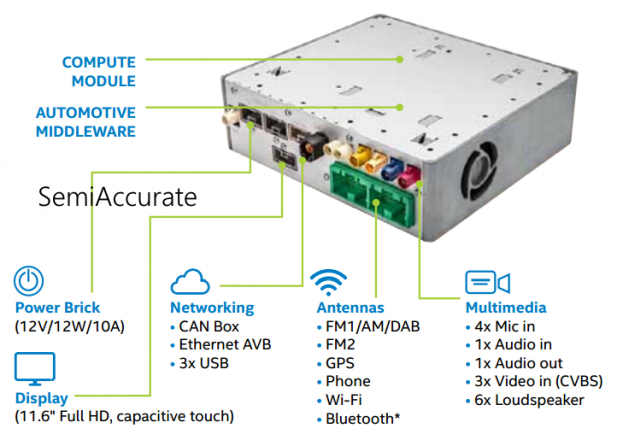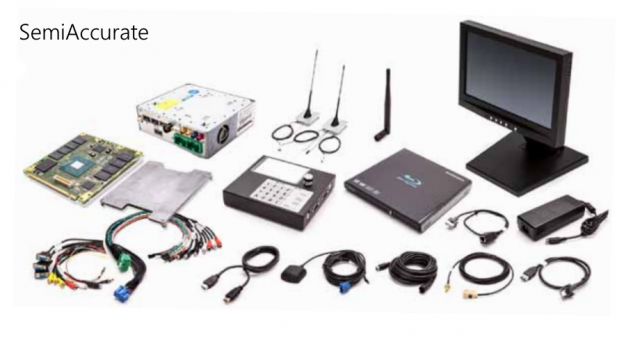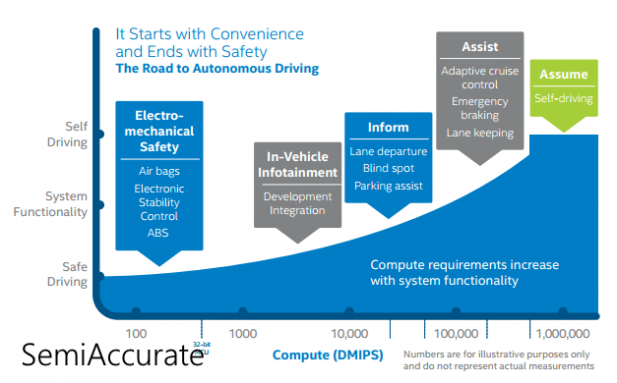In a news briefing today Intel announced that it would begin offering a new family of complete systems called Intel In-Vehicle Solutions (IIVS). As part of this announcement Intel is now offering a development kit to car manufactures. This development kit is billed as an application-ready, in-vehicle infotainment solution that is a complete physical system. It comes packaged as a single DIN sized small form factor PC with an array of antennas, cables, disc drives, and even an 11.6” touch screen display. Intel is providing both the Atom-based internals and the software that runs on top of that thanks to the work of its subsidiary Wind River and its partners like QNX.
If Intel’s plan to control the Internet of Things is going to work then offering a family of products to automakers like the IIVS is a necessity. That said due to the highly proprietary nature of automotive computer systems it’s hard to get all that excited about an announcement like this one. Intel is committed to serving the automotive market and it appears that they are offering a complete solution to automakers in the form of the IIVS product family to do so. But it’s extremely difficult to judge the competitiveness of Intel’s infotainment solutions because of extremely private and application specific nature of the automotive market.
One topic that Intel did touch on with this announcement is its expectations for the future needs of compute in the automotive market. According to Intel the level of compute required to operate a car will plateau once we reach the realm of self-driving cars. Currently there is a mix of informative and assistive technology in our cars, but we do not have self-driving cars. As I argued in my piece on Apple’s CarPlay a few months ago there is a practical ceiling to the need for compute in automobiles. I defined this ceiling as the current and arriving generation of infotainment solutions and said that more compute was not required in automobiles because CarPlay and solutions like it use the car’s infotainment system as a dumb terminal and would use the compute in our phones rather than our cars. In my discussion I did not address the need for additional compute to handle the self-driving functions of the vehicle.
Let me propose a new roadmap for the future of compute in our cars. As it stands today we have reached, or are about to reach, the point of having enough compute for the basic systems of a car and the infotainment systems in cars. If tablets have proven anything it’s that the amount of compute required to drive a 10” touch screen is surprisingly small. But self-driving systems and technologies will require additional compute and will likely drive the next generation of products from Intel, Nvidia, and Qualcomm. These systems will need to prioritize sensor sampling speed and I/O latency above all else. The advent of self-driving cars will require more compute than current generation in-car solutions can provide but it will also place even more importance on the platform of software and sensors that compute is connected to rather than onto the compute itself.
When the self-driving car finally arrives I think that the hardware vendors like Intel will begin offering SoC’s that are designed specifically for use in self-driving cars rather than just rebadged mobile offerings because of the latency requirements of this application. In a self-driving car anything you can do to reduce the time between the car detecting a threat and responding to that threat is going to improve the safe of vehicle and its passengers/cargo. Additionally the inflection point that the transition to self-driving cars represents may be an opportunity for Intel and company to increase their margins in this traditionally low-margin, medium to high volume market.
Stepping out of that discussion Intel’s new IIVS family looks like a solid offering. But we have very few ways to gauge its competitiveness outside of counting design wins which is an imperfect indicator given Intel’s $100 investment fund and recent embrace of contra revenue. Intel has a foothold in the automotive market and it’s making the right moves to cater to automakers. But it’s still fighting against a plethora of ARM vendors that are currently holding the high ground. Congrats to Intel’s IoT team for launching their latest automotive offering.S|A
Thomas Ryan
Latest posts by Thomas Ryan (see all)
- Intel’s Core i7-8700K: A Review - Oct 5, 2017
- Raijintek’s Thetis Window: A Case Review - Sep 28, 2017
- Intel’s Core i9-7980XE: A Review - Sep 25, 2017
- AMD’s Ryzen Pro and Ryzen Threadripper 1900X Come to Market - Aug 31, 2017
- Intel’s Core i9-7900X: A Review - Aug 24, 2017


